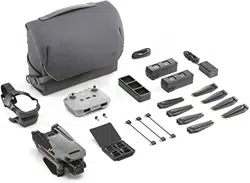Loading ...
Loading ...
Loading ...

DJI Mavic 3
User Manual
22
©
2021 DJI All Rights Reserved.
Vision Systems have limited ability to sense and avoid obstacles, and the performance may be
Using the Vision Systems
When GNSS is unavailable, the Downward Vision System is enabled if the surface has a clear texture
and sufficient light.
The Forward, Backward, Lateral, and Upward Vision Systems will activate automatically when the
aircraft is powered on if the aircraft is in Normal or Cine mode and Obstacle Avoidance is set to Bypass
or Brake in DJI Fly. The aircraft can actively brake when detecting obstacles when using the Forward,
Backward, Lateral, and Upward Vision Systems. The Forward, Backward, Lateral, and Upward Vision
Systems work best with adequate lighting and clearly marked or textured obstacles. Due to inertia,
users must make sure to brake the aircraft within a reasonable distance.
affected by the surrounding environment. Make sure to maintain visual line of sight with the aircraft
and pay attention to prompts in DJI Fly.
The Downward Vision Systems work best when the aircraft is at an altitude from 0.5 to 30 m if there
is no GNSS available. Extra caution is required if the altitude of the aircraft is above 30 m as the
Vision Systems may be affected.
The Auxiliary Bottom Light can be set in DJI Fly. If set to Auto, it is automatically enabled when the
environment light is too weak. Note that the Vision System cameras performance may be affected
when the Auxiliary Bottom Light is enabled. Fly with caution if the GNSS signal is weak.
The Vision Systems may not function properly when the aircraft is flying over water or snow-covered
areas. Aircraft may not be able to land properly over water. Make sure to maintain visual line of sight
with the aircraft and pay attention to prompts in DJI Fly.
The Vision Systems cannot work properly over surfaces that do not have clear pattern variations. The
Vision Systems cannot work properly in any of the following situations. Operate the aircraft cautiously.
a. Flying over monochrome surfaces (e.g., pure black, pure white, pure green).
b. Flying over highly reflective surfaces.
c. Flying over water or transparent surfaces.
d. Flying over moving surfaces or objects.
e. Flying in an area where the lighting changes frequently or drastically.
f. Flying over extremely dark (< 10 lux) or bright (> 40,000 lux) surfaces.
g. Flying over surfaces that strongly reflect or absorb infrared waves (e.g., mirrors).
h. Flying over surfaces without clear patterns or texture.
i. Flying over surfaces with repeating identical patterns or textures (e.g., tiles with the same design).
j. Flying over obstacles with small surface areas (e.g., tree branches).
Keep the sensors clean at all times. DO NOT tamper with the sensors. DO NOT use the aircraft in
dusty or humid environments.
Vision System cameras may need to be calibrated after being stored for an extended period. A
prompt will appear in DJI Fly and calibration will be performed automatically.
DO NOT fly when it is raining, foggy, or if there is no clear sight.
Check the following before each takeoff:
a. Make sure there are no stickers or any other obstructions over the Infrared Sensing and Vision Systems.
b.
If there is any dirt, dust, or water on the Infrared Sensing and Vision Systems, clean it with a soft
cloth. Do not use any cleanser that contains alcohol.
c. Contact DJI Support if there is any damage to the glass of the Infrared Sensing and Vision Systems.
DO NOT obstruct the Infrared Sensing System.
Loading ...
Loading ...
Loading ...
